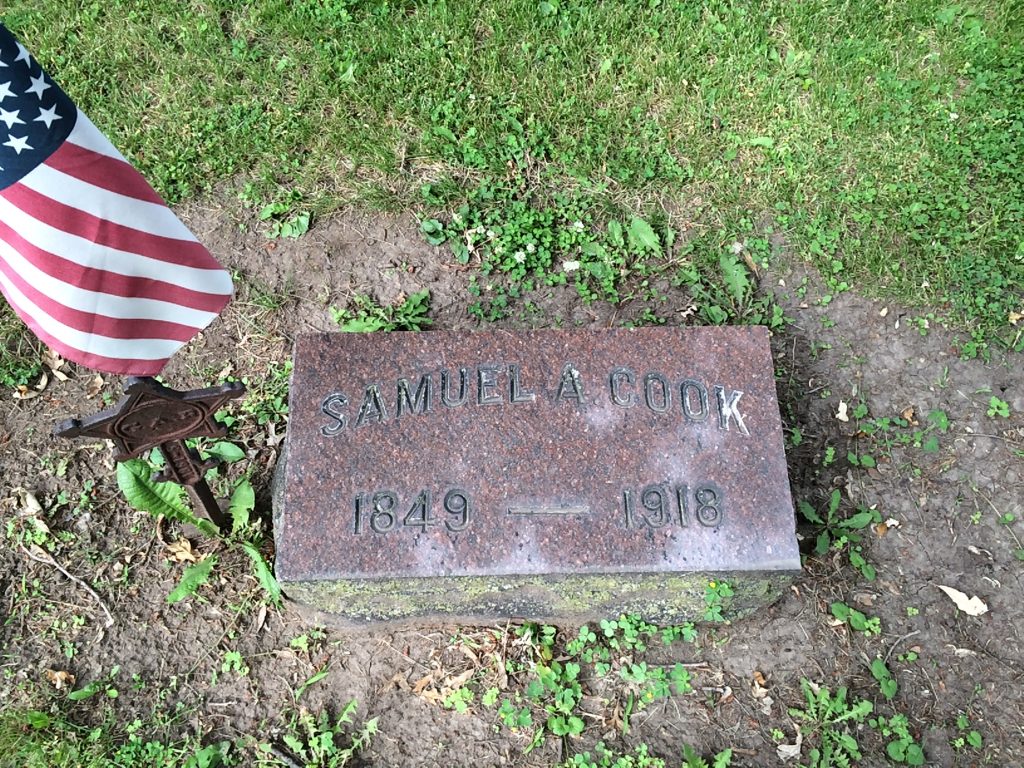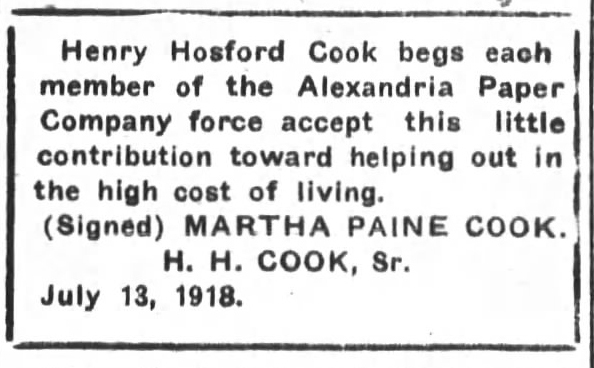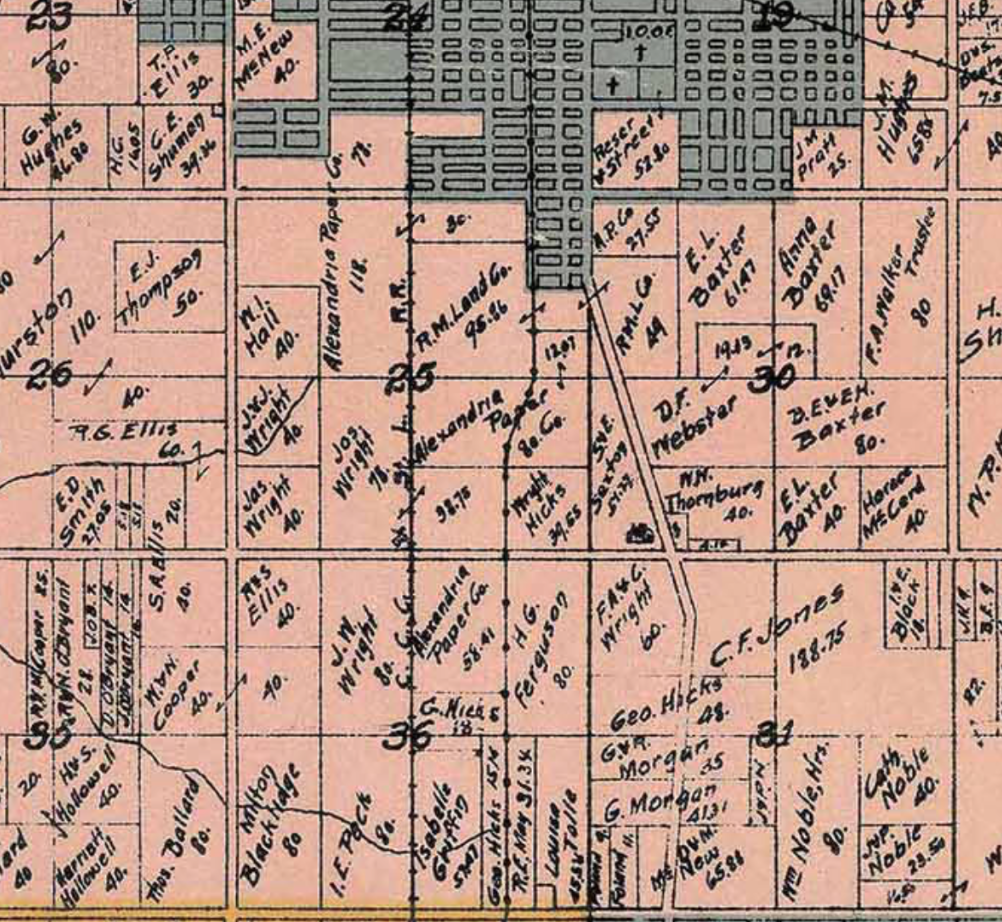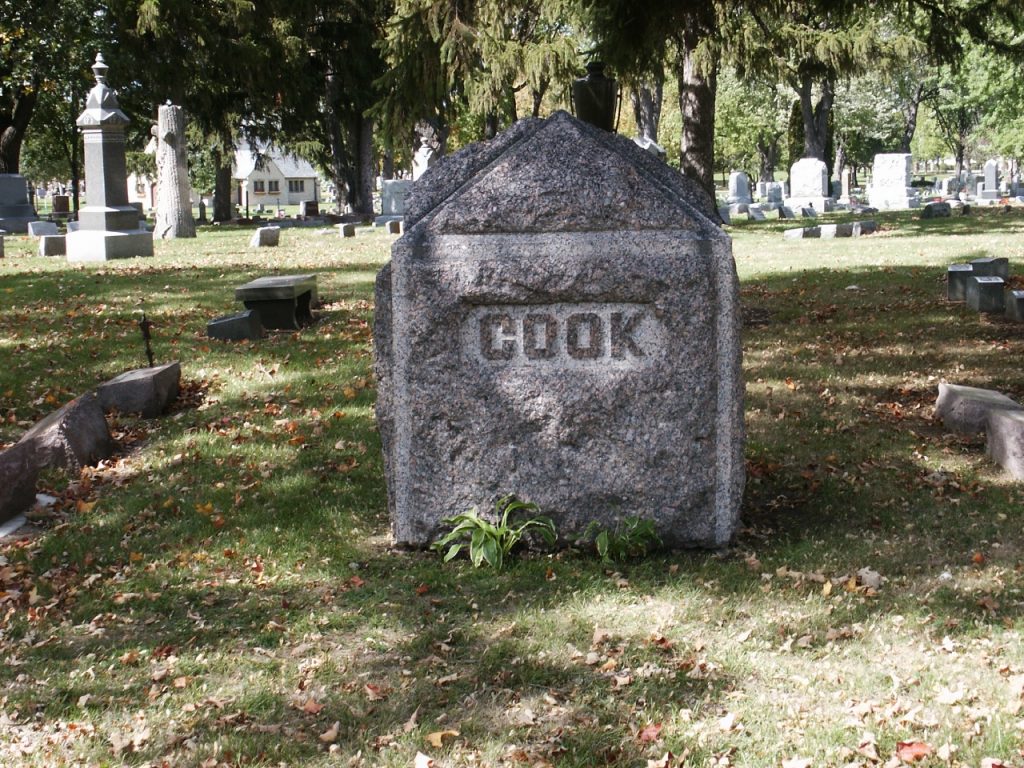Harry and Martha
The United States entered World War I on April 6, 1917. In early May he joined other men from Alexandria traveling to Fort Benjamin Harrison in Lawrence, Marian County, Indiana to take the field artillery examination for entrance into officer’s training school.[1] He was “told by officials that he could do more good for his country by returning to Alexandria and look after his factory.”[2]
Harry returned to Alexandria determined to help in any way that he could. With this goal in mind, he created what the boys would name: Camp Cook. “Seventy-five acres of fine soil south of the new beautiful home of Harry Cook” was prepared for the potato seed that he had ordered from Wisconsin. Harry intended to provide the people of Alexandria and the government with potatoes at cost.[3] He reached out to the Boy Scouts of Madison County to plant, tend, and harvest the potato crop.
Carpenters from the mill arranged the camp and erected tents for the approximately 30 boys who would arrive in June. A final detail was to have the water flowing from the well south of mill was safe. Upon arrival at the camp, the boys erected a fifty-foot flag pole, enclosed the area with a fence, and planted flowers.
The potatoes were ready for harvest the first week of October. Orders were taken at the paper mill office, $1.25 per bushel. No deliveries would be made. “As soon as the people here are supplied, the potatoes will be sold to the government.”[4]
As Harry worked to enlarge the paper mill’s farm, he purchased 21 cows and heifers in Wisconsin and had them shipped to Alexandria. Charles Lancaster, now head of the agricultural and livestock department, took charge of the shipment.[5]
Liberty Bonds was the government’s chosen way to pay for the war. There were four campaigns to sell the bonds; the second campaign started October 1, 1917, and Harry, on behalf of the Alexandria Paper Mill, purchased $50,000 in bonds. The bonds were credited to both the Alexandria and Commercial banks. Harry stated that the employees of the mill would purchase their bonds from the company.[6]
At the November 14, 1917 stockholder meeting of the Commercial Bank & Trust Company, both Harry and Edwin Yule were elected as directors. “Both gentlemen are citizens of Alexandria and both are well known as business men of superior qualifications and integrity.”[7]
As winter turned to spring, Harry’s thoughts again turned to baseball. Westside Park where “many a hot baseball game has been stages with some of the fastest independent teams in the state is no more.” The land had been purchased, the grandstand and fence removed, and the ground returned agriculture. The “land will be leased for farming purposes to help win the war.” In response to the decision to raze the ballpark, Harry made the statement that “Alexandria will have one of the fastest independent ball clubs in the state after the close of the war.”[8]
S. A. was failing. In late 1917 he had suffered a stroke, and while unable to get around, had been in good spirits. On April 4, 1918, with both of his children at his bedside, “Shortly after four o’clock at his home on North Commercial street this morning death closed the career of Ex-Congressman S. A. Cook.” News of his death “cast a shadow of sadness over the entire community” of Neenah and Menasha. “Young and old alike respected this big citizen and his memory will long be honored by those, and they include all, who were privileged to call him friend.”[9] Samuel Andrew Cook was 69 years old.
Two thousand people attended his funeral held at the armory that bore his name. The services were brief and included a reading of scripture by the pastor of the Presbyterian church, followed by a prayer by the pastor of the First Methodist Church, and remarks from the pastor of St. Patrick’s Catholic Church. Following his remarks, the G.A.R. assumed charge, and the remains were taken to Oak Hill Cemetery where he was laid to rest next to his wife, Jennie.[10]
Harry and Martha were expecting their first child, a son, born on July 13, 1918. The joy S.A. would have felt at welcoming his first, and only grandchild, who was named Henry Hosford Cook. Hosford being the maiden name of Martha’s mother, Elizabeth May Hosford Paine.
Hosford (or Cookie as he was affectionately called), was born in Chicago, Cook County, Illinois at Presbyterian Hospital. His father was 37 years old, and his mother, 23. They listed their residence as the Alpaco Farms in Alexandria.[11]
The proud father made a quick trip to Alexandria on July 17th, before returning to Chicago.[12] While he was at the mill he presented each of the 160 employees a $10.00 bill accompanied by an engraved card.[13] In a 1970 interview, Robert W. Gaither shared this memory of the event: “One occasion that sticks in Mr. Gaither’s mind was the day Harry Cook’s son was born. ’I remember so well,’ he said, ‘when Harry sat on the steps of the old office building and gave everyone who came through a ten-dollar bill.’”[14]
A few days later on July 31, Harry called an emergency meeting of the Alexandria Paper Mill stockholders. With the passing of S.A., there was a need to elect new company officers. At that meeting, Harry was named president and general manager, Charles Lancaster, vice-president, and Edwin Yule, secretary and treasurer. The company as “one of the flourishing institutions” of Alexandria, was running year-round and employed about 160 men.[15]
The fourth and final Liberty Loan campaign began on September 24, 1918. On the 26th, Harry headed to the Liberty Loan headquarters and purchased a subscription for $25,000, making it the largest single voluntary subscription for this campaign.[16]
A year after his father’s death, S.A.’s estate was settled. The Daily Northwestern reported that after all of the provisions of S.A.’s will were met, the remaining estate to be distributed “included $320,002.11, the Cook homestead at Neenah and eight lots in Hennepin county, Minnesota.” This was to be “assigned in equal shares” to Harry and his sister, Maud.[17]
I have stated before that S.A. was a serial entrepreneur. I believe he thoroughly enjoyed the challenges of creating a company from scratch. The thrill of watching an idea grow and flourish. He also had the skill to run a successful business, to put into leadership roles the personalities and skill sets that will work together to further his idea. This is not an easy thing to do. Many people get it wrong, and companies flounder and fail. I believe his success was due not only to his ability to understand a business but because he was a good, honest man.[18] A testament to his business acuity is the amount of his remaining estate. In his will he was very generous to many people and organizations. Very generous. Yet the amount remaining to be distributed equally between his children was $320,002.11 (love the eleven cents). Entering this number into the calculator at www.usinflationcalculator.com that amount today is equivalent to $5,049,799.77. And that is just the cash distribution, the property he owned is not part of this amount. The will does not mention the 16 acres in Alexandria upon which the house sits.
The receipt of such a large inheritance prompted Harry to write his will. The will was witnessed on April 30, 1919. It bequeathed one-third of his property to his wife, Martha Paine Cook; one-third to his sister, Maud Lancaster, and one-third to be held in trust for Hosford.[19]
While Martha may not have been a big fan of baseball and football, she was an avid tennis player. While speeding three months of the summer of 1919 at her parent’s home in Oshkosh, she had participated in a tennis tournament. This sparked the idea of a new tennis court at the house. In June, plans were drawn for the new court which was to be located across the road from the home on the “Anderson Pike.” “The new tennis court will be equipped with all the latest tennis equipment.”[20] Work began on the court in September. and by October was “the scene of some fast tennis set.” This first court must have been a grass court, as plans were already in place to replace the current court with a “concrete court early in the spring.”[21]
Harry was a lover of automobiles, and he was specifically a fan of the Locomobile, having owned several over the years. In April 1914 he traded in his six-cylinder Winton touring car for a brand new Locomobile Torpedo Stern Roadster, capable of doing 90 mph.[22] He traded in the roadster in March 1917 for a Locomobile touring car with a yacht body.[23] I believe this is the car that was valued at $8,000 in July 1919. The car made the news on July 9th, when The Times=Tribune reported that a “Short Circuit Caused a Blaze In Front Seat.” Harry had been having ignition problems and had the car in for service. Returning home that evening he discovered a smoldering fire under the front seat. A bucket brigade was “hastily organized,” and the blaze was extinguished. The damage was covered by insurance.
Charles and Maud passed through Alexandria on their way to the Pacific coast in late October. In their honor, Harry and Martha threw a small house party. “The out-of-town guests were Senator and Mrs. Austin Retherford. Hallowe’en decorations prevailed.”[24] On November 7th the newspaper reported that the Lancasters continued on their journey west, with plans to stop in Neenah.[25] The reason to mention this? As they had been “guests at the home of Mr. and Mrs. Harry Cook,” indicates that they had not kept a residence in Alexandria.
Harry again showed his generosity when at Thanksgiving he gave a “Thanksgiving Remembrance” to each employee of the paper mill, the farm employees, as well as “the employes at the Cook home.” 160 employees received a $5.00 bill as a Thanksgiving remembrance.[26]
Christmas was a quiet affair for the small family. Shortly after the new year, Harry traveled to New York City on business. While in New York he caught what he thought was a cold. The cold was so bad that it sent him to the hospital. It was not a cold, he had contracted Sleeping Sickness.
As this is to be a story of the house, I invite you to read more of Harry and Martha’s story here: She Was Hopeful Till the End – Part 1, She Was Hopeful Till the End – Part 2, A Child Lost and A Mother’s Grief.
The 1920 United States Federal Census was enumerated on January 29, 1920. The house was not yet a numbered residence. H. H. Cook was enumerated as the Head of Household, age 38, President of a Paper Company. It was noted that he owned the house, free of a mortgage. Residing with him were his wife, Martha, age 25, and son, Henry H. age 1.
The census is enumerated first as Households, second as Families living within the household, and third each Individual included in the family. Residing in the Cook household, as a separate family, were the Jordans. John F. Jordan, age 58, listing his relation to the Head of Household as Servant. I find this fascinating; I would have expected him to be listed as the Head of his own household, as he was renting his living quarters. John worked as the caretaker for the Cook property. Living with John, was Mary Jordan, age 56, Servant, working as the Cook, and Opal Jordan, age 15, Servant, working as a Table Maid.[27]
By August 1920, Martha and Hosford were residing full-time in Oshkosh, the Jordans continued to stay in the house, acting as caretakers.
In August 1921 Mary “housekeeper at the Harry Cook home, south of town” reported to The Times=Tribune that the “White Rock pullets hatched April 8 are now laying.[28] This is quite remarkable for a pullet so young to be laying.” I am sure that she regretted that contacting the newspaper as the next day “Chicken thieves got into the Cook chicken house at the home place on the paper mill grounds Sunday night and stole 35 White Rock chickens.” “No clue to the thieves has been discovered.”[29]
In January of 1923 after living on the Cook property for five years, the Jordans decided to move into their own home in the city.[30] Mary continued to serve as housekeeper and caretaker of the property. In August of that year, she arranged for the house to be “painted a beautiful white, which is very attractive to passersby.” As a thank you to the three men who spent days on the job, she “entertained” them at dinner. In return for her hospitality, the men presented her with an aluminum roaster.[31]
The house was now standing vacant. Mary was at the house only “intermittently to air and clean” since her move into town. She had last been on the property in early November 1924. On January 10th she got an uneasy feeling and decided that she needed to check on the house. She no longer had a personal set of keys, so she called a the paper mill office for keys and went to the house. It had been broken into.
The “thieves had gained entrance through a basement window on the north side of the house. The window was hidden from the road by the sun parlor which has a projection to the north. Three outside doors were found unlocked.” “Every room had been entered and the contents of all drawers, wardrobes, closets, pantries and even the attic had been rummaged. In the latter place, a sharp knife had been used to cut through a trunk. The contents were strewn promiscuously about the floor of the attic.”
A partial list of the articles stolen are: a “cabinet Victrola; an electric vacuum sweeper, a new broom; an entire set of fine china; glassware; a cut glass punch bowl; a carving set; all bed linen, table linen and towels; a small Victrola broken and the motor removed leaving only the box; all wool blankets and comforts; pillows; electric lamps; four overcoats; two dozen shirts; and may other articles.”[32] The thieves “were evidently equipped with one of those giant moving vans into which four or five tons can be loaded and hauled away without any trouble.” “A local wag wanted to know how come they didn’t ‘pack away the huge colonial pillars in front of the residence.’”[33] The “palatial residence of Harry Cook” was not the only robbery, the May hardware store had also been robbed. The police had no clue but stated, “that in both cases the robberies were committed by professionals making a tour of the state in autos.”[34] There is no further mention of the robbery, or who the thieves may have been.
The house remained in both Harry and Martha’s names until some time after February 1928 when Martha filed for divorce. At that time she received a “portion of the furnishings of the Cook home just south of the city, which has been unused since the separation.”[35]
Henry Harold Cook passed away on January 25, 1931, in Atlantic City, Atlantic County, New Jersey. He was 49 years old. Harry was brought to Neenah for burial and was buried near his parents in Oak Hill Cemetery.
SOURCES:
- “For Field Artillery,” The Times-Tribune, 9 May 1917, p. 3, col. 1; digital images, Newspapers.com (www.newspapers.com : accessed 31 Aug 2021).
- “Our Boys Santa Claus Fund,” The Times-Tribune, 27 Nov 1917, Tuesday, p. 1, col. 6; digital images, Newspapers.com (www.newspapers.com : accessed 17 Jun 2016).
- “Potatoes To Sell At $1.25 A Bushel,” The Times-Tribune, 8 Oct 1917, Monday, p. 1, col. 5; digital images, Newspapers.com (www.newspapers.com : accessed 27 May 2016).
- Ibid.
- “Pure-Bred Dairy Herd Arrives,” The Times-Tribune, 9 Jul 1917, p. 4, col. 2; digital images, Newspapers.com (www.newspapers.com : accessed 1 Sep 2021).
- “Paper Company Subscribes $50,000,” The Times-Tribune, 26 Oct 1917, Friday, p. 1, col. 1; digital images, Newspapers.com (www.newspapers.com : accessed 1 Sep 2021).
- “H. H. Cook and E. W. Yule Now Directors,” The Times-Tribune, 15 Nov 1917, Thursday, p. 1, col. 6; digital images, Newspapers.com (www.newspapers.com : accessed 24 May 2016).
- “Farewell Baseball,” The Times-Tribune, 14 Mar 1918, p. 1, col. 2; digital images, Newspapers.com (www.newspapers.com : accessed 16 Jul 2016).
- “Death Closes Career of Ex-Congressman S. A. Cook,” Neenah Daily Times, 4 Apr 1918, Thursday, p. 1, col. 1; digital images, Newspapers.com (www.newspapers.com : accessed 22 Jan 2019).
- “The Funeral of Mr. Cook.,” The Oshkosh Daily Northwestern, 8 Apr 1918, Monday Evening, p. 5, col. 1; digital images, Newspapers.com (www.newspapers.com : accessed 15 Dec 2016).
- FamilySearch, “Illinois, Cook County Birth Certificates, 1878-1922,” database and images, FamilySearch (www.familysearch.org : accessed 4 Jul 2012); Henry Hosford Cook; Reference ID: 25709, GS Film Number: 1308838, Digital Folder Number: 004403114, Image Number: 01020.
- “Cook Says ‘All’s Well’,” The Times-Tribune, 18 Jul 1918, Thursday, p. 1, col. 5; digital images, Newspapers.com (www.newspapers.com : accessed 27 May 2016).
- “Munificence of Mr. and Mrs. Cook,” The Times-Tribune, 22 Jul 1918, Monday, p. 1, col. 6; digital images, Newspapers.com (www.newspapers.com : accessed 27 May 2016).
- Sue Marston, “Old Paper Mill Will Again Have A Heart Beat,” The Times-Tribune, 15 Apr 1970, Wednesday, p. 8; digital images, Newspapers.com (www.newspapers.com : accessed 19 May 2016).
- “Alexandria Paper Co. Holds Annual Election,” The Times-Tribune, 1 Aug 1918, Thursday, p. 1, col. 3; digital images, Newspapers.com (www.newspapers.com : accessed 18 May 2016).
- “One $25,000 Subscription,” The Times-Tribune, 26 Sep 1918, Thursday, p. 1, col. 7; digital images, Newspapers.com (www.newspapers.com : accessed 27 May 2016).
- “Settle Cook Estate,” The Oshkosh Daily Northwestern, 17 Apr 1919, Thursday Evening, p. 10, col. 1; digital images, Ancestry.com (www.ancestry.com : accessed 29 Apr 2016), Newspapers and Magazines.
- I need to compile a list of descriptive phrases that have been published about Samuel A. Cook.
- “Cook’s Sister Gets Large Part of His Estate,” The Times-Tribune, 11 Aug 1931, Tuesday, p. 1, col. 5; digital images, Newspapers.com (www.newspapers.com : accessed 19 May 2016).
- “New Tennis Court,” The Times-Tribune, 13 Jun 1919, Friday, p. 1, col. 2; digital images, Newspapers.com (www.newspapers.com : accessed 19 May 2016).
- “Tennis At Cook Home,” The Times-Tribune, 7 Oct 1919, Tuesday, p. 1, col. 6; digital images, Newspapers.com (www.newspapers.com : accessed 19 May 2016).
- “A High Powered Machine–,” The Times-Tribune, 30 Apr 1914, Thursday, p. 1, col. 3; digital images, Newspapers.com (www.newspapers.com : accessed 20 Apr 2016).
- “Cook Purchases New Car,” The Times-Tribune, 23 Mar 1917, Friday, p. 1, col. 7; digital images, Newwpapers.com (www.newspapers.com : accessed 17 Jun 2016).
- “Mr. and Mrs. H. H. Cook Entertain,” The Times-Tribune, 31 Oct 1919, Friday, p. 1, col. 2; digital images, Newspapers.com (www.newspapers.com : accessed 27 May 2016).
- “On Their Way West,” The Times-Tribune, 7 Nov 1919, Friday, p. 1, col. 5; digital images, Newspapers.com (www.newspapers.com : accessed 24 May 2016).
- “Thanksgiving Remembrance,” The Times-Tribune, 26 Nov 1919, Wednesday, p. 1, col. 3; digital images, Newspapers.com (www.newspapers.com : accessed 24 May 2016).
- 1910 U.S. census, Madison County, Indiana, population schedule, Monroe Township, enumeration district (ED) 122, sheet 9, p. 48A, dwelling 206, family 207-208, H. H. Cook household; digital images, Ancestry.com (www.ancestry.com : accessed 25 Mar 2003); citing National Archives and Records Administration microfilm T624, roll 449.
- “Laying At Tender Age,” The Times-Tribune, 3 Aug 1921, Wednesday, p. 1, col. 6; digital images, Newspapers.com (www.newspapers.com : accessed 24 May 2016).
- “Steal 35 Fine White Rock Chickens At Cook Home,” The Times-Tribune, 9 Aug 1921, Tuesday, p. 1, col. 5; digital images, Newspapers.com (www.newspapers.com : accessed 24 May 2016).
- “Planning To Move In Their Own Home Soon,” The Times-Tribune, 20 Jan 1923, Saturday, p. 1, col. 6; digital images, Newspapers.com (www.newspapers.com : accessed 20 Jun 2016).
- “Mrs. Jordan Entertains,” The Times-Tribune, 3 Aug 1923, Friday, p. 1, col. 5; digital images, Newspapers.com (www.newspapers.com : accessed 24 May 2016).
- “Bold Thieves Break Into The Cook Home,” The Times-Tribune, 10 Jan 1925, p. 1, col. 7; digital images, Newspapers.com (www.newspapers.com : accessed 24 May 2016).
- The Times-Tribune, 12 Jan 1925, Monday, p. 1, col. 2; digital images, Newspapers.com (www.newspapers.com : accessed 24 May 2016).
- “No Clue to Robbers Who Looted the Cook Home,” The Times-Tribune, 13 Jan 1925, p. 1, col. 6; digital images, Newspapers.com (www.newspapers.com : accessed 24 May 2016).
- “Life Insurance Policy $25,000 to Mrs. Cook,” The Times-Tribune, 21 Feb 1928, p. 1, col. 2; digital images, Newspapers.com (www.newspapers.com : accessed 24 May 2016).





